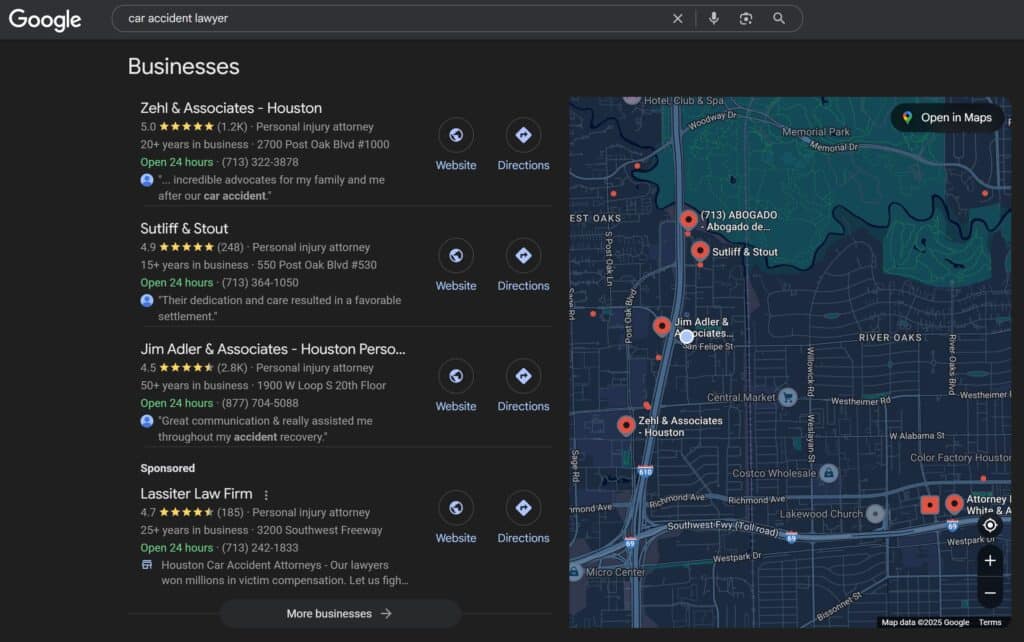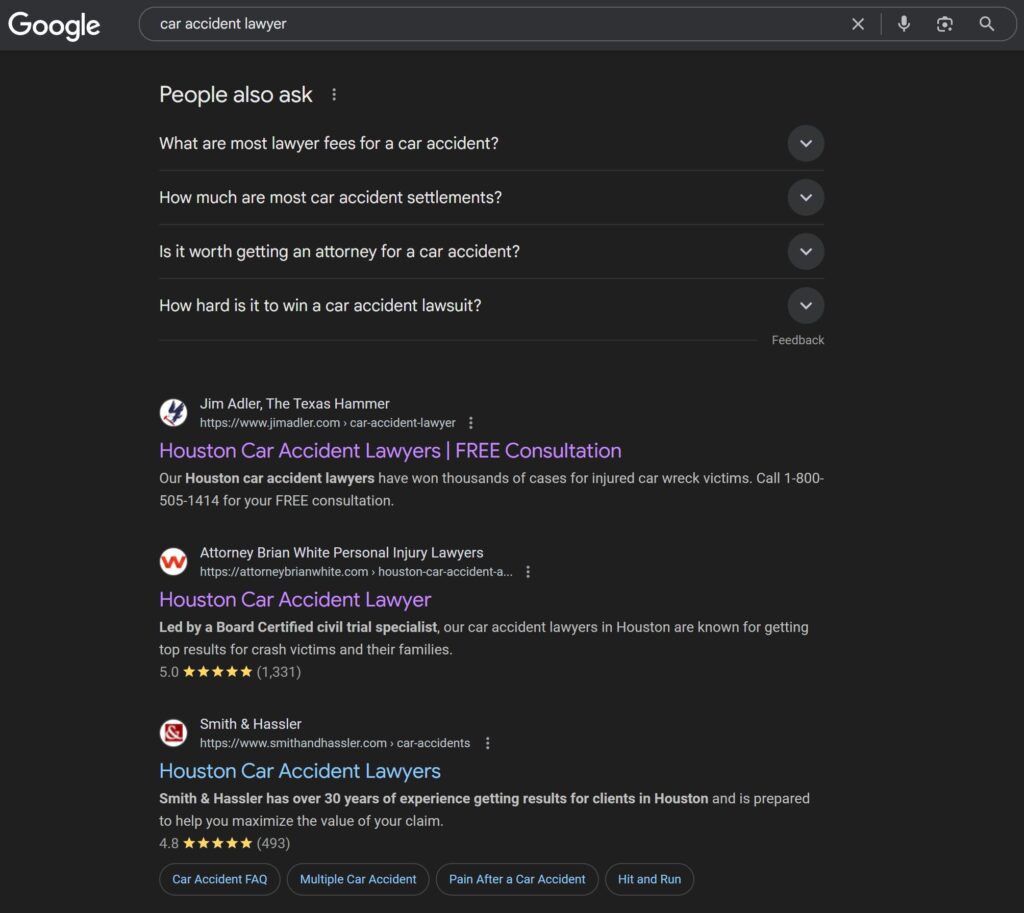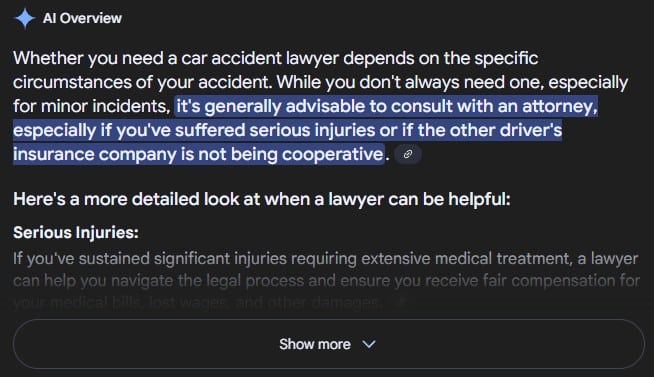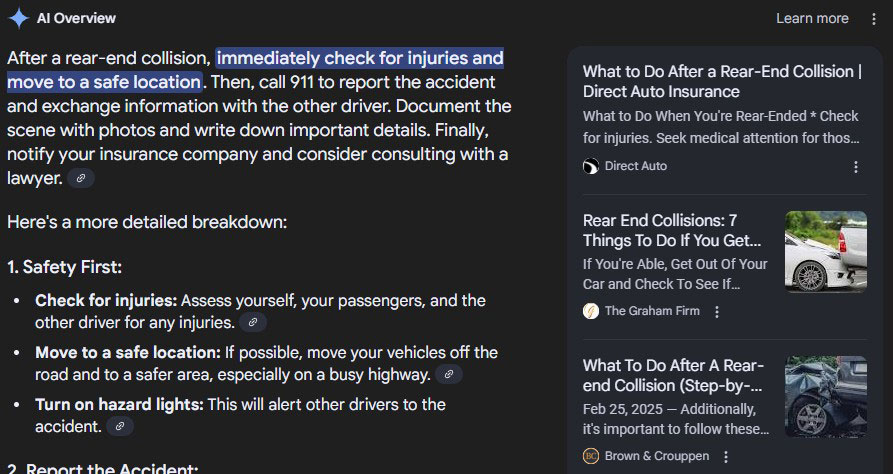Google has transformed the landscape of search…again.
And law firms that don’t adapt risk getting buried beneath AI-generated summaries, disappearing map packs, and zero-click results.
Does that mean SEO is going away? Absolutely not.
But it’s evolving.
This guide unifies everything you need to know about the future of SEO for law firms.
I’ll break down Google’s new AI Overviews, explain why traditional SEO playbooks are outdated, and show how to future-proof your digital strategy using Answer Engine Optimization (AEO), structured data, and real trust signals.
How Google’s AI Overviews Are Changing Legal Search
Google’s new AI Overviews are front-loading direct answers into search results—pushing traditional organic results further down the page.
What’s happening:
- Fewer clicks to websites
- More featured snippets, FAQs, and AI-generated summaries
- Higher value placed on clarity, authority, and semantic richness
For law firms, this means:
- FAQ content and structured answers matter more than ever
- You’re no longer optimizing just for “rankings”—you’re optimizing for inclusion in answers
- Thin blog posts and outdated landing pages will be ignored by AI systems
Here’s an explainer video from Google:
Answer Engine Optimization (AEO): What It Is and Why It Matters
AEO is the new frontier of SEO. Instead of just optimizing pages for keywords, you’re optimizing to answer questions directly in AI systems.
Core AEO Principles
- Clear H1s and subheads with intent-match phrasing
- Concise paragraph and bullet-style answers (1–2 sentences max)
- Internal linking between related question clusters
- Schema markup: FAQ, HowTo, Article, LocalBusiness
Example
Instead of this:
Do this:
A: Call 911, document the scene, and contact a local car accident lawyer immediately.
Structured Data: The Language of AI Search
Google and AI overviews rely on schema markup to extract context. Without it, even great content can be invisible.
Essential Schema for Law Firms
- LocalBusiness + Attorney (for Google Business Profile data)
- FAQPage (to trigger snippets)
- Article (for blog content authority)
- Review (to display ratings)
Use Google’s Rich Results Test to check implementation.
The Role of E‑E‑A‑T in the AI Era
AI systems don’t just need answers—they need trustworthy answers.
E‑E‑A‑T (Experience, Expertise, Authoritativeness, Trustworthiness) is now more important than ever:
- Experience: Share real cases, client testimonials, first-person insights
- Expertise: Highlight bar admissions, years practicing, legal focus
- Authority: Earn backlinks from .edu, .gov, local media
- Trust: Embed clear CTAs, privacy pages, HTTPS, and office addresses
The more you can “prove” your legitimacy in markup and content, the more likely AI is to use your material.
Visuals: AI Overviews vs Traditional SERPs
Diagram 1: Old-School SERP
- 10 blue links (purple if you already clicked it like I did, lol)
- Map pack at the top or middle of the search page
- FAQ dropdowns (“People also ask”)


Diagram 2: New AI Overview Layout
- AI summary box with citations
- No map pack shown
- Fewer blue links, more zero-click answers

AI Overviews (expanded):

What these images are telling us:
- There’s displacement “above-the-fold”
- Citations are being used (AI pulling from trustworthy sources)
- Schema is triggering a website’s inclusion
How Law Firms Should Adapt Their SEO Strategy in 2025
- Turn every blog post into an answer hub
- Add collapsible FAQs
- Use structured headers
- Optimize paragraph summaries
- Re-audit your site with AEO intent
- Is each service page answering real user questions?
- Are pages structured clearly with header tags?
- Update old content
- Remove fluff and unnecessary filler
- Add schema to your pages
- Use fresher examples and data, give more in-depth answers
- If necessary, use 301 redirects to relevant but newer, better content
- And if it really sucks – 410 it (don’t 404)
- Prioritize zero-click visibility
- You may not get the click—but if your brand is featured in the answer, you win authority
- Get featured by AI
- Use NLP-friendly phrasing, authoritative tone, and unique insights
Checklist: Future-Proofing Your Law Firm SEO
Here’s a practical checklist to make sure your law firm’s website is optimized for the AI-driven future of search:
- Site uses FAQPage, Article, and LocalBusiness schema
- Every major practice area page includes collapsible Q&A
- Images include descriptive filenames and ALT tags
- Google Business Profile is optimized + active
- Internal linking strategy connects clusters around questions
- External links from .edu, .gov, or legal blogs
- All blog posts updated for AEO intent
- Visual hierarchy (H1–H3) follows topic logic
The Ultimate Takeaway
AI isn’t going to destroy legal SEO. But it is rewriting the rules. Law firms that adapt to AEO, schema, and NLP formatting will pull ahead—while others keep playing by an outdated rulebook.
Let’s get you in the future of search.
Get an AEO Audit for Your Firm
Unsure if your site is optimized for AI Overviews or structured for future Google updates?
Get a personalized AEO Audit. I’ll analyze your:
- Schema structure
- Content format
- Legal topic authority
- Visibility in AI-generated answers


